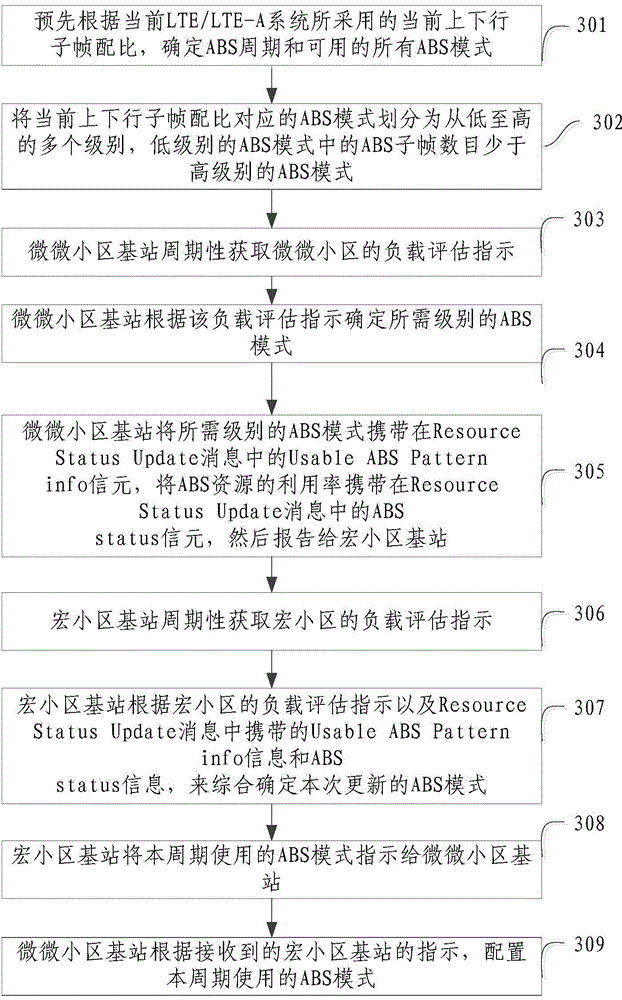Downlink interference coordinating method and base stations
An interference coordination and base station technology, applied in the field of communications, can solve problems such as reducing system resource utilization, affecting interference coordination performance, etc., and achieves the effect of high interference coordination performance and optimized configuration
- Summary
- Abstract
- Description
- Claims
- Application Information
AI Technical Summary
Problems solved by technology
Method used
Image
Examples
Embodiment 1
[0079] Embodiment 1 of the present invention proposes a method for realizing dynamic downlink interference coordination in a pico cell base station, see figure 1 , the method includes:
[0080] Step 101: Divide the ABS modes corresponding to each uplink-downlink subframe ratio into multiple levels from low to high.
[0081] Step 102: The pico cell base station periodically obtains the load evaluation indication of the pico cell.
[0082] Step 103: The pico cell base station determines the required level of ABS mode according to the load evaluation indication, and reports to the macro cell base station;
[0083] Step 104: The pico cell base station configures the ABS mode used in this period according to the received instruction from the macro cell base station.
[0084] according to figure 1 It can be seen from the flow shown that Embodiment 1 of the present invention proposes a dynamic downlink interference coordination scheme. The pico cell base station determines the req...
Embodiment 2
[0089] Embodiment 2 proposes a method for realizing dynamic downlink interference coordination in a macro cell base station, see figure 2 , the method includes:
[0090] Step 201: Divide the ABS pattern corresponding to each uplink-downlink subframe ratio into a plurality of levels from low to high, wherein the number of ABS subframes in the low-level ABS mode is less than that in the high-level ABS mode.
[0091] Step 202: The macro cell base station periodically acquires a load evaluation indication of the macro cell.
[0092] Step 203: The macro cell base station determines the ABS mode used in this period according to the load evaluation indication of the macro cell and the required level of ABS mode reported by the pico cell base station.
[0093] Step 204: The macro cell base station indicates the ABS mode used in this period to the pico cell base station.
[0094] in the above figure 2 In the flow shown, the macro cell base station finally determines the ABS mode u...
Embodiment 3
[0113] This embodiment takes the process of coordinating between a pico cell base station and a macro cell to realize dynamic downlink interference coordination as an example, and describes a better coordinating process of the two in detail. image 3 ,include:
[0114] Step 301: Determine the ABS period and all available ABS patterns in advance according to the current uplink and downlink subframe configuration adopted by the current LTE / LTE-A system.
[0115] Step 302: Divide the ABS patterns corresponding to the current uplink-downlink subframe ratio into multiple levels from low to high, and the number of ABS subframes in the low-level ABS modes is less than that in the high-level ABS modes.
[0116] For example, the currently used uplink and downlink subframe ratio is uplink and downlink subframe ratio 1. According to the process from step 301 to step 302 above, the available ABS mode and level settings are shown in Table 1 below: In Table 1, "1 " means configured as ABS...
PUM
 Login to View More
Login to View More Abstract
Description
Claims
Application Information
 Login to View More
Login to View More - R&D
- Intellectual Property
- Life Sciences
- Materials
- Tech Scout
- Unparalleled Data Quality
- Higher Quality Content
- 60% Fewer Hallucinations
Browse by: Latest US Patents, China's latest patents, Technical Efficacy Thesaurus, Application Domain, Technology Topic, Popular Technical Reports.
© 2025 PatSnap. All rights reserved.Legal|Privacy policy|Modern Slavery Act Transparency Statement|Sitemap|About US| Contact US: help@patsnap.com



